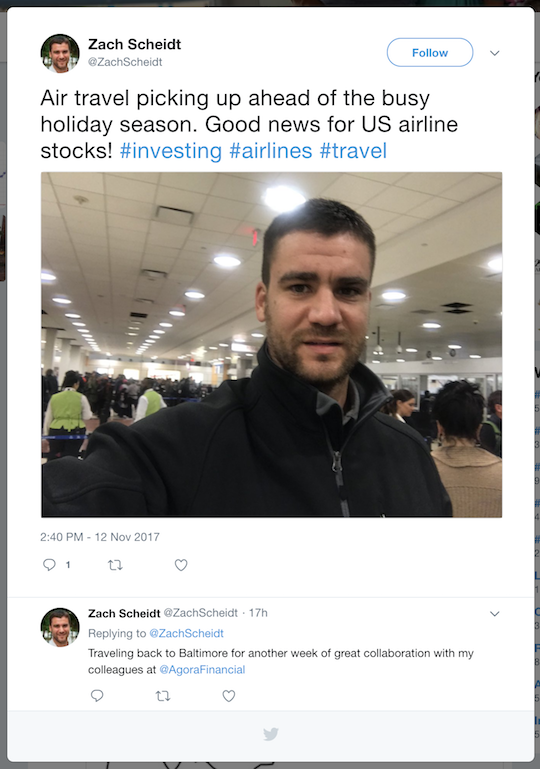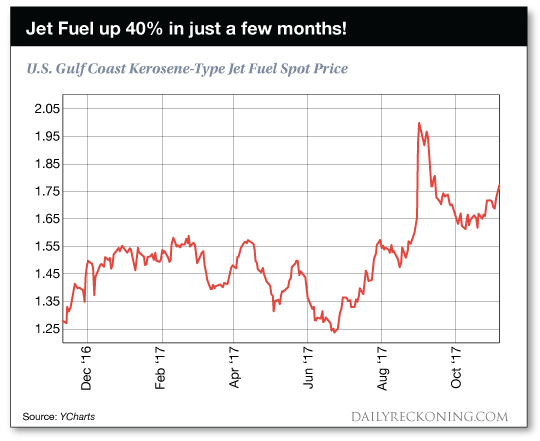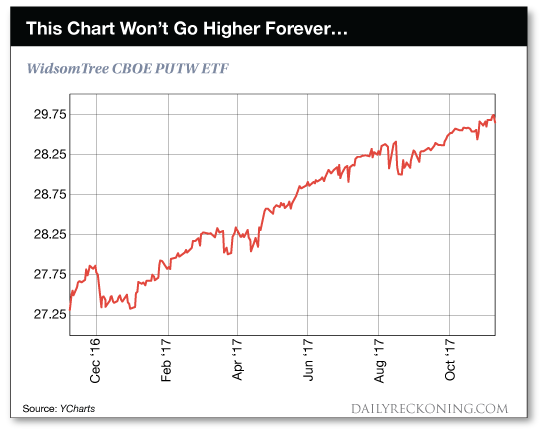"We're Sorry. Your Flight Is Full"?I'm sorry sir, but we're completely booked. You'll have to wait for the next flight out.? That's the story I got from the gate agent last night as I tried to make my way back to Baltimore. I had made it to the airport ahead of schedule and thought I had a shot at catching an early flight. With all the flying I do, the airline staff are usually more than willing to help me out with flight changes. But unfortunately, Southwest is operating at capacity and there was no way they could fit me in. Incidentally, there were no open seats on my scheduled flight which took off about 90 minutes later. Every seat was booked, giving Southwest Airlines (NYSE:LUV) another very profitable flight in the books. Today, I want to tell you a bit more about the strong U.S. demand for airline travel, and how you as an investor can take advantage of this trend… A Busy Season for Airline TravelIt looks like U.S. travel is starting to pick up early this year - even before the notorious "busy season" which officially kicks off the week of Thanksgiving. Last night, on what I expected to be a relatively low key Sunday evening through the airport, security lines were surprisingly long. 
According to what I'm seeing in my research, travelers can get used to long lines and full planes for the coming holiday season. Late this summer, USA Today reported that U.S. airlines saw a 5% increase in traffic for Labor Day, shuttling 16.1 million passengers that holiday weekend. 1 Thanksgiving weekend is typically the heaviest and most concentrated travel day for U.S. airlines, and this year analysts are expecting 28.5 million people to fly between Friday November 17 and Tuesday November 28 - up 3% from last year.2 Add it all up, and you've got a strong period for airline profits… One that should drive Airline stock prices higher. A Limited Time Travel DiscountWhile the outlook for holiday travel (and airline profits) looks very attractive, airline stocks are currently trading at discount prices. That's because investors are looking at the wrong data. About a month ago, I told you about some travel statistics that were heavily skewed by hurricanes Harvey and Irma. The two major storm systems hit the U.S. in rapid succession, causing U.S. airlines to cancel flights. These cancellations naturally cut into profitability, catching the attention of investors. It also hasn't helped that jet fuel prices have been rising alongside the rally for crude oil. Below, you can see that the price of jet fuel has increased by roughly 40% just since the end of June. 
While both of these issues (the hurricane disruptions and higher fuel prices) are real issues that have real financial impacts, both should be temporary. It's clear to see how the two consecutive hurricanes were a "perfect storm" that cut into summer profits but shouldn't be a long-term drain on airline profitability. Higher fuel prices should also be a temporary issue simply because of the supply and demand dynamics in energy markets. Today, U.S. oil producers have access to vast reserves of oil trapped in shale formations. These formations used to be too expensive to drill. But now, thanks to fracking technology, the oil can be economically pulled out and added to U.S. production. The higher oil prices trade, the more incentive there is for U.S. producers to tap into these reserves. And when they do, the extra supply hitting the markets should drive the price of oil lower. In other words, we're reaching a new equilibrium point for oil that should keep the price of oil from trading much higher (and could drive oil lower early next year). So I expect to see the price of jet fuel coming back down, just in time for record travel this holiday season. Now is a great time to start stocking up on U.S. airline investments while you can still buy them at a discount! Here's to growing and protecting your wealth! 
Zach Scheidt
Editor, The Daily Edge
Twitter ? Facebook ? Email 5 Must Knows For Monday Nov. 13th Bitcoiners Beware- Over the weekend, Bitcoin plunged 29% from its high which equated to about $38 billion off its market cap. As I write this, the cryptocurrency is trading around $6,550, which is still $1000 off its high mark. Remember, if you're invested in cryptocurrencies, only risk money that you can afford to lose. I recommend less than 5% of your overall portfolio. Oil Cuts?- OPEC Secretary General Mohammad Barkindo stated in a conference in Abu Dhabi over the weekend that production cuts are their ?only viable option.? This could mean there are some profitable times ahead for U.S. shale producers as the increase in price could be enough for them to bring the thousands of unfinished wells online. General Electric Cuts Dividend- GE is holding its annual investor meeting this week and we've already got some big news out of it - General Electric has cut its dividend by 50%. Although that is one of the most attractive attributes about owning the stock, the price seemed to be unphased in the premarket. In addition, CEO John Flannery also announced that GE will primarily focus on aviation, power and health care. Mergers Don't Come Easy- Two high-profile mergers are proving to be difficult for the acquiring firm this week. First, Qualcomm is getting set to rebuke the $103 billion offer from Broadcom, which could mark the beginning of the largest ever takeover battle. And second, AT&T is hitting snags in its acquisition of Time Warner. More specifically, the Justice Department has requested that AT&T sell off assets like CNN and TBS in order for the deal to go through - so far AT&T is not complying. Earnings Season Rolls On- One of the most exciting times of the year for investors is finally winding down, but there are still a few Daily Edge favorites that are yet to report. This week, look for Cisco, Home Depot, Wal-Mart and Target to all report earnings. 1 Airlines expect all-time high 16 million travelers for Labor Day holiday, USA Today, Bart Jansen
2 This Will Be the Busiest Air Travel Day of Thanksgiving Weekend, Fortune, Claire Zillman In Case You Missed it…Buyer Beware: Instant Income Knockoffs  Hi [%= :subscriberName(E, Reader) %], Hi [%= :subscriberName(E, Reader) %],
I recently got an excited email from a colleague of mine. Matt found a mutual fund that followed a similar strategy to the Income on Demand approach I use with our paid subscribers. "Can I just quit selling puts and invest my money in this fund instead?" Matt asked me point blank. I have to admit, the thought intrigued me at first. But as I looked into the details, I figured out that there were some big problems with this mutual fund. Today, I want to show you what I uncovered, to make sure you don't make the same mistake Matt almost fell into? A Similar ? But Flawed ? Investment StrategyThe fund that my colleague mentioned was the WisdomTree CBOE S&P 500 PutWrite Strategy Fund (PUTW). The fund follows an index called the CBOE S&P 500 PutWrite Index (PUT). This index is deceptively similar to the instant income strategy that we use at Income on Demand. But instead of selling put contracts to collect cash payments from individual stocks, the PUT index sells put contracts on the S&P 500. [Editor's Note: If you are unfamiliar with our Income on Demand strategy and the instant income that our subscribers are generating, click here for more information.] Each month, the index sells a number of put contracts on the S&P 500 index. The instant cash from this transaction is collected and invested in Treasury bills to earn a very low rate of interest. At the end of the month, one of two things will happen. If the S&P 500 index is trading above the put strike price, the puts will expire and disappear. This is very similar to how our put contracts for individual stocks expire. This expiration frees up cash for the PUT index to sell more S&P 500 put contracts. On the other hand, if the S&P is trading below the put strike price, the index will have to make a cash payment to cover the difference between the actual price of the S&P 500 and the strike price. This process is very different from our Income on Demand strategy. For our strategy, we sell put contracts on individual stocks, and accept shares of stock that we want to own. But it is impractical for the fund to accept all the stocks in the S&P 500. So a cash payment is made to close out the trade. The fund then sells new put contracts for the next month and starts the process over again. Unfortunately, while this difference may seem subtle, it makes a huge difference for the fund's ultimate returns. Why You Should Avoid This High-Risk Fund In looking at the structure for this put-writing fund, I found two key differences between how the index invests and how we collect our instant income payments. First, our Income on Demand strategy collects instant cash payments from individual stocks while the fund collects payments from a very broad index of stocks. I'd much rather collect payments from individual stocks, because this approach gives us much more control over our income. Each week, I screen thousands of stocks to find our very best Tuesday morning opportunity. In particular, I'm looking for stocks that are very likely to trade higher, have a healthy business (limiting our downside risk) and have options that pay us plenty of cash. By running my screens and being very selective with which stocks we use, I'm able to help you collect the biggest income payments while limiting your risk of stocks pulling back. Unfortunately, the PUT fund strategy is at the mercy of the market. Each month, the fund must sell put contracts on the entire market. It doesn't matter if the puts are cheap (and give only a small amount of income) or if there's a significant amount of risk in the market. Like a robot, this fund will simply follow a blind path and take whatever cash the market is willing to give ? regardless of the risk. The second difference from our Income on Demand strategy is the way our positions are managed. If the market pulls back, the PUT fund must throw in the towel at the end of the month and take whatever losses are currently in play. That's very different from the way I manage our income trades? As you know, when our shares pull back, we automatically buy shares of stock at our agreed-upon price. This goes back to the importance of only picking shares that we want to own. Once we buy shares in our account, we're then able to turn around and collect more income by selling call contracts for these shares. This is a great way to continue to collect income over and over ? until our shares are sold and our position is closed out at a profit. I'd much rather have control ? and an ongoing income stream ? instead of accepting a loss every time the market pulls back. Picking up Nickels in Front of a Bulldozer If you look at a historical chart for the PUTW fund, you'll notice that the fund has been increasing in value since the fund started last year. There have been very few short-term pullbacks. 
That's exactly what you want to see in an investment fund, right? Well, not so fast? The fund has been increasing in value simply because the S&P 500 has been steadily advancing. We're currently in a bull trend that has lasted for an excessively long period. It's natural for this fund to make money when the market is moving higher. But let's look a little more closely at the return for this fund. In February 2016, the fund began with a $25 per share price. Today, the fund is trading near $29.44, which is good for a 17.8% gain. That may sound attractive until you see what the S&P 500 index did over that time. During the same period, the S&P 500 rose from 1,917.78 to this week's price near 2,557. That's a 33.3% return over the same time period. So the S&P 500 nearly doubled the put-writing fund's return! Keep in mind this is one of the best-case scenarios for the PUTW fund. We're currently in a market environment that has featured steady advances and very few pullbacks. When the market inevitably pulls back, this fund will likely be crushed! That's because the PUTW fund is still on the hook for nearly the entire loss that the S&P 500 will experience during a pullback. So while the fund made modest gains during a steady market advance, it will experience full losses when the market pulls back. Traders often refer to this type of strategy as "picking up nickels in front of a bulldozer," because you're getting paid a little bit day by day but accepting way too much risk of getting squashed. A more colorful analogy is "eating like a bird and crapping like an elephant." The point is this fund strategy may look attractive on the surface, but don't be fooled. You're much better off using our instant income strategy at Income on Demand to selectively pick the very best income opportunities and to protect your wealth by managing your risk. Here's to growing and protecting your wealth! 
Zach Scheidt
Editor, The Daily Edge | 
